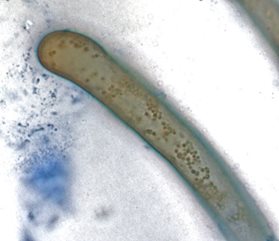First in the series Unlocking Plant Root Potential: A Conversation with Dr. James White
For Dr. James White and his team of researchers at
Rutgers University, giving credence to the rhizophagy cycle and the microbes that fuel it has proven to yield a new understanding the symbiotic relationship between the soil biome and plant root hairs.
In February, I attended a presentation by Dr. White and, in March, had the opportunity to follow-up with him in a discussion of his team’s work and what their findings may mean for agricultural production. In the following series of blogs, we discuss the discovery of the rhizophagy cycle and what may be the true role of root hairs, along with the process of plant microbe farming.
The Rhizophagy Cycle
In 2010, a team of Australian microbiologists from the University of Queensland published research findings on interactions between plants and microbes in the soil. These symbiotic relationships, they discovered were initiated and cultivated by the plant; microbes enter the cells of the root hair and provide nitrogen and other nutrients as they are subsequently digested by the plant. The team coined this nutrient process as the Rhizophagy Cycle.
1
Building on this research, White and his team recently published on the rhizophagy cycle’s process of nutrient exchange and extraction.
2
“It has taken eight years of research, but what we have added to what is known about the rhizophagy cycle is that it is a cyclic process of delivering nutrients to the plant,” White says. “It is interesting, we are always taught, from third grade and beyond, that plants have root hairs and those root hairs absorb nutrients. But what we see in our research is that those root hairs have the function of putting microbes—and not just any microbes, but those most adapted to the specific needs of the plant—into the rhizosphere to acquire more nutrients.”
The importance of root hairs

Root hair showing bacteria red-brown color in hair and ejection of bacteria gray-blue color from the tip of the hair.
Photo courtesy of Dr. James White
This evidence leads White and his team to conclude that perhaps root hairs play a much more important role in the nutrient cycle than merely absorbing nutrients from the soil biome, and, he says, this information makes it tempting to speculate that the role of root hairs is symbiotic to microbial activity.
“We know that if we remove all of the microbes, we get no hairs forming on the plant roots,” White says, “So this makes us think that one of the primary roles of root hairs is to elevate microbes back out into the soil. We also know that most roots have no root hairs; only the tips of the root have root hairs. And, where are microbes found? At the tip of the root, where the root hairs are. Older parts of the root will not have any root hairs on them at all. Both are functional, the roots with hairs and the ones without, so it makes you wonder if we got it wrong about root hairs playing only an absorptive role.”
Root hairs are very active organs, and the team’s research has proven that microbes are being circulated and replicated within the root hair. White says that, in turn, their research has shown that the root hairs are not only functional in replicating microbes, but in extracting nutrients from them, placing them back into the soil biome and then nurturing them back to being productive.
“The plant initially attracts microbes, either from the soil or from the seed. It cultivates those microbes on its root system, internalizes them to absorb nutrients and then ejects them back into the soil biome to gather more nutrients; it is also evident that the plant feeds the exudate microbes. These plant-provided carbon nutrients give the microbes what they need to recover and reform their flagella to swim out into the soil and acquire more nutrients,” he says. “Root hairs seem to have everything to do with microbes.”
Related links
References
- Paungfoo-Lonhienne, C, et al. 2010. Turning the Table: Plants Consume Microbes as a Source of Nutrients. PLos One, 5(7). https://www.ncbi.nlm.nih.gov/pmc/articles/PMC2912860/
- White, JF, et al. 2018. Rhizophagy Cycle: An Oxidative Process in Plants for Nutrient Extraction from Symbiotic Microbes. Microorganisms, 6(3). https://www.ncbi.nlm.nih.gov/pmc/articles/PMC6164190/